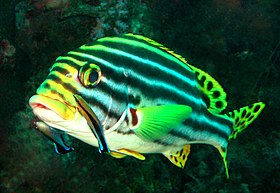
Back تلون الحيوانات Arabic Coloración animal Spanish رنگآمیزی جانور Persian Coloración animal Galician जंतुओं के रंग Hindi Livrea Italian Umaszczenie Polish د څارويو رنګ Pashto/Pushto Coloração em animais Portuguese Окраска животных Russian


Animal colouration is the general appearance of an animal resulting from the reflection or emission of light from its surfaces. Some animals are brightly coloured, while others are hard to see. In some species, such as the peafowl, the male has strong patterns, conspicuous colours and is iridescent, while the female is far less visible.
There are several separate reasons why animals have evolved colours. Camouflage enables an animal to remain hidden from view. Animals use colour to advertise services such as cleaning to animals of other species; to signal their sexual status to other members of the same species; and in mimicry, taking advantage of the warning coloration of another species. Some animals use flashes of colour to divert attacks by startling predators. Zebras may possibly use motion dazzle, confusing a predator's attack by moving a bold pattern rapidly. Some animals are coloured for physical protection, with pigments in the skin to protect against sunburn, while some frogs can lighten or darken their skin for temperature regulation. Finally, animals can be coloured incidentally. For example, blood is red because the haem pigment needed to carry oxygen is red. Animals coloured in these ways can have striking natural patterns.
Animals produce colour in both direct and indirect ways. Direct production occurs through the presence of visible coloured cells known as pigment which are particles of coloured material such as freckles. Indirect production occurs by virtue of cells known as chromatophores which are pigment-containing cells such as hair follicles. The distribution of the pigment particles in the chromatophores can change under hormonal or neuronal control. For fishes it has been demonstrated that chromatophores may respond directly to environmental stimuli like visible light, UV-radiation, temperature, pH, chemicals, etc.[1] colour change helps individuals in becoming more or less visible and is important in agonistic displays and in camouflage. Some animals, including many butterflies and birds, have microscopic structures in scales, bristles or feathers which give them brilliant iridescent colours. Other animals including squid and some deep-sea fish can produce light, sometimes of different colours. Animals often use two or more of these mechanisms together to produce the colours and effects they need.
- ^ Meyer-Rochow, VB (2001). Fish chromatophores as sensors of environmental stimuli - Book=Sensory Biology of Jawed Fishes; editors Kapoor BG & Hara TJ; Science Publishers Enfield (NH), USA. pp. 317–334.
© MMXXIII Rich X Search. We shall prevail. All rights reserved. Rich X Search